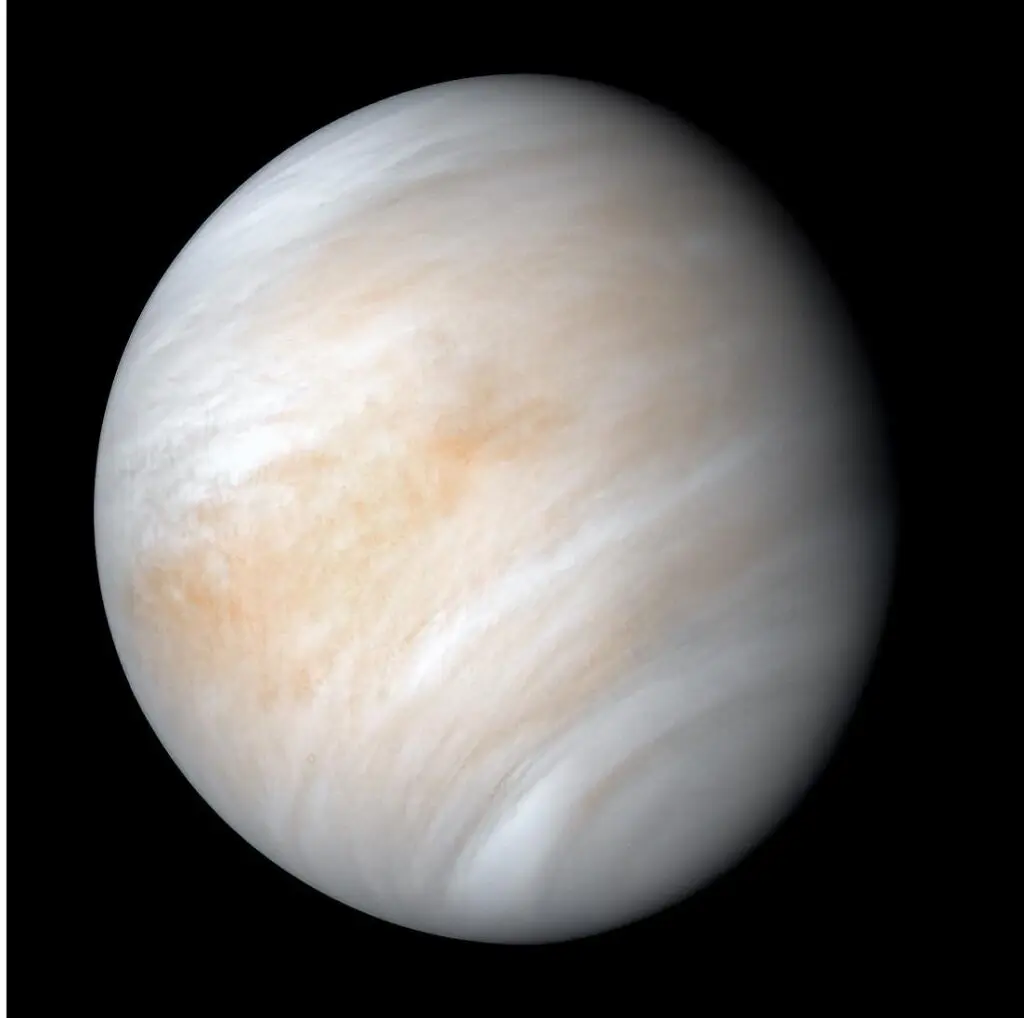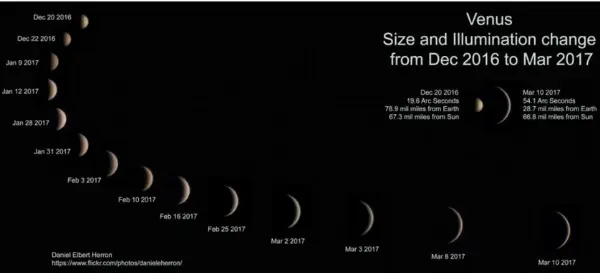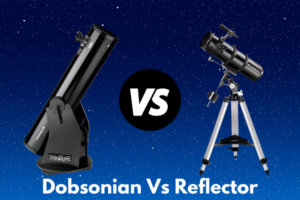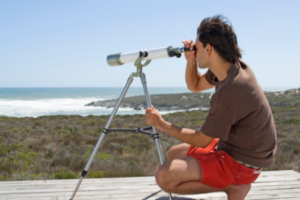How To See Venus Through A Telescope: 5-Minute Read
Disclosure: This post contains affiliate links and I may earn a small commission (at no extra cost to you) if you click through and make a purchase. Thanks in advance – I really appreciate it!
When I got my first telescope, I spent the first few nights looking at the Moon. My very next goal was to find Venus in the night sky and observe it in detail. When viewed with naked eyes, Venus looks like a star. But unlike stars that emit their own light, Venus reflects the light of the Sun.
Key Takeaways:
Can you see Venus through a telescope?
During the month of January, Venus can be seen through a telescope at dawn before sunrise, then it begins to move too close to the Sun and cannot be viewed for the next few months. It reappears in May and remains visible at dusk near the western horizon throughout the second half of the year.

Source: NASA
Venus is considered to be Earth’s sister, as Venus is a planet similar in size to Earth. It is the second-brightest object in the night sky, after the moon. Finding it is easy when it is visible.
This article will show you where and when to look for Venus, and what you can see when you point your scope at Venus.
Related: 11 Best-Selling Telescopes For Viewing Planets
How To View Venus Through A Telescope
Venus is a hostile planet. It is covered by thick reflective clouds that hide its surface and trap heat, much like a greenhouse.
It has a surface temperature of almost 900 degrees Fahrenheit and is the hottest planet in our Solar System.
Because its dense clouds reflect so much sunlight into space, it is the third brightest object visible from Earth after the Sun or Moon.
Venus catches our eye and prompts us to look up at it with our telescopes, whenever it’s visible during the year.
In terms of luminosity, it can reach a magnitude-4.7, which is 17 times brighter than Sirius, which is the brightest star in the night sky, So, how do we know when Venus is visible in the morning or evening sky?
Related: Mars Vs. Venus – All The Differences & Similarities
When Is Venus Visible In 2021?
Venus is almost always seen as either an ‘evening star’ or a ‘morning star’.
It is closer than us to the Sun, so we can only see it from our perspective when it is to our side.
You can expect to see Venus in the morning and evening skies during these periods in 2021:
Morning: January 1 to January 23
This is the best time period to view Venus through a telescope as it will be visible low near the east-southeastern horizon before dawn.
By the end of January, Venus would have moved too close to the Sun to be seen for the next few months.
Evening: May 24 to December 31
After a summer break, the brightest planet makes a welcome reappearance in May evenings, where she remains as an evening ‘star’ for the rest of the year.
Venus will be visible at dusk near the western horizon till December and as the months go by, Venus will only increase in brightness.
On October 29, Venus reaches its greatest eastern elongation of 47 degrees from the Sun. However, because the ecliptic is on a low angle then, Venus looks better for viewing in November and December.
On December 5, Venus will be the brightest in the evening sky and will shine at magnitude -4.7 at an altitude of about 13 degrees above the southwestern horizon.
How To Find Venus in the Night Sky With Your Phone
It can be difficult to identify constellations, stars or planets in the sky if you’re just getting started in astronomy.
If this is also the case with you, you can easily locate Venus or any other celestial object with your smartphone. Numerous astronomy apps can be downloaded on your smartphone to help you locate planets, stars, and comets in no time.
To look for a planet or a star, open the app on your phone and simply place your phone in front and drag it across the sky. The application will show you a real-time overlay of what’s in the sky.
There’s a lot to see. You can use the search function of most apps to help you find what you’re looking for.
You may use Planetarium apps such as Stellarium, SkySafari 6, or Google Maps. to know the exact location of Venus in the sky.
When Is The Best Time To View Venus With A Telescope
It is best to observe any planet when it is closest to Earth. Venus is the second nearest planet to the Sun and Earth is third.
This configuration makes it impossible for Venus to be seen through a reflecting telescope or a refracting telescope at night.
This is because Venus follows closely the Sun’s path across the sky, and it can only be seen at dawn before sunrise and at dusk after the sunset.
As we know that Venus being an inner planet, is never far from the Sun.
However, if the planet is placed at an angle of 45 degrees between the Sun and the Earth, it is known as the greatest elongation. In the case of Venus, this is around 46 degrees.
It can happen one or two times a year, but it is not a common occurrence every year.
The greatest elongations are the best times to see Venus through a telescope.
During the greatest elongations, Venus will either rise from the horizon three hours before the sun or will set in the horizon about three hours after the sunset.
When Will Venus Be At Its Brightest In 2021
Venus is generally the brightest at least twice a year. This year Venus will slowly keep becoming brighter from January to March. It will then reach a dazzling brightness of the magnitude -3.9.
The brightness of Venus will then begin to drop gradually for approximately 3 months. It will start becoming brighter again around mid-July and will reach a brightness of -4.88 magnitude in the month of December.
The best time to see Venus through a telescope in 2021 is just after sunset, around October 29.
What Type Of Telescope Do You Need To View Venus
Any telescope can be used to see Venus. While the optical design of a telescope is not important to view a certain planet, Dobsonian telescopes are the preferred type of telescope to view planets in great detail.
Any other type of reflecting/refracting telescope is fine too, as long they have an aperture of at minimum 2.5 inches (62mm), as well as a long focal length of 800mm or more.
A larger aperture will give you a better view, but you can still see Venus with a beginner’s telescope.
Telescopes with GoTo and tracking abilities are the best type of telescopes to view Venus as they can keep Venus centered throughout your viewing sessions for a more stabilized view.
A telescope magnification of 50x per inch of aperture is generally considered sufficient to observe Venus. You can try to use a Barlow lens if the atmosphere is stable.
If you want to see more of Venus’ details, you should consider buying a 25% moon filter. This will filter out the light of our moon when looking at Venus directly.
Below are some really good telescopes that can be easily set up and used to view Venus and other wonders of the night sky.
Orion 8944 SkyQuest XT6 Classic Dobsonian Telescope is perhaps one of the best beginner Dobsonian reflector telescopes you can buy with a big 6″ aperture at an amazing price. The large aperture and f/8 parabolic mirror are fantastic for Moon and planetary views, and also have enough light grasp for deep-sky viewing of nebulas, galaxies, and star clusters.
The Celestron AstroMaster 130EQ is another powerful reflector telescope for astronomy beginners that can give you amazing views of Venus and other celestial objects. It features fully-coated glass optics, a sturdy and lightweight frame, 2 eyepieces, a StarPointer red dot finderscope, and an adjustable tripod.
Celestron – NexStar 127SLT Computerized Telescope is designed as an entry- to mid-level astronomical observation platform. With 127mm aperture and f/12 focal length, this amazing Maksutov-Cassegrain GoTo Telescope gives users the ability to make detailed observations of the Moon, with the ability to easily see planets and reach outside the solar system to resolve distant objects like galaxies, nebulae, and binary or variable stars.
What To Look For When Observing Venus With A Telescope

Source: NASA Science
Venus is just like our Moon in that it goes through phases as it orbits the Sun.
The phases of Venus are clearly visible with a telescope of moderate magnification as it waxes and wanes,
It is interesting to note that Venus appears brighter and bigger during its crescent phases than it is during the near-full phase, due to its proximity to Earth.
Venus has very little to show other than its phases. Its surface is forever obscured by thick clouds filled with sulfur dioxide.
The majority of amateur astronomers will therefore be able only to view the phases of the moon through their telescope.
And unlike Saturn and Jupiter with their swirling clouds and cloud bands, Venus’s clouds are stable and will show very little detail.
Conclusion
Venus is a wonderful target for new observers. If you know how and where to look, it’s easy to spot. It can be viewed naked eye or with binoculars. But, it’s best to view it through a telescope.
Venus is one of the best targets to begin practicing astronomy. It’s a lot of fun to watch its transitions through the different phases.
Frequently Asked Questions
1. Why is it hard to see Venus through a telescope?
It is difficult to see Venus through a telescope because its surface is perpetually covered in thick clouds of sulfur dioxide. Other than slight variations due to light scattering in the Earth’s atmosphere, Venus generally appears white and without any discernable features.
2. What magnification do you need to see Venus?
Depending on the time of year, Venus can be observed using a telescope of at least 62mm (2.5”) aperture or greater with a magnification of 50x.
3. Can Venus be seen at night with a telescope?
Depending on the time of year, Venus can be seen with a telescope for a few hours at the beginning or end of the night.
Written by:

Kavya Joshi
My love affair with space began in a field in India at the age of 7, when I looked up at the Milky Way for the first time. Ever since, I have been attempting to cram in every fact about the Universe, I can find into my head.
ABOUT US
We are a team of active amateur astronomers, here to help you with all your astronomy and science related needs – this is anything, from reviewing the latest telescopes to be released to talking about gravity and neurons. The Big Bang Optics was started because of our love for astronomy and to help others like us find the best telescope and accessories.
LEGAL DISCLAIMER
The Big Bang Optics is a participant in the Amazon Services LLC Associates Program, an affiliate advertising program designed to provide a means for sites to earn advertising fees by advertising and linking to Amazon.com. The Big Bang Optics also participates in affiliate programs with Clickbank and other sites. The Big Bang Optics is compensated for referring traffic and business to these companies.




